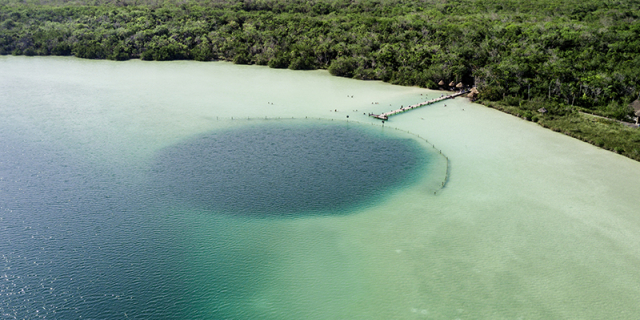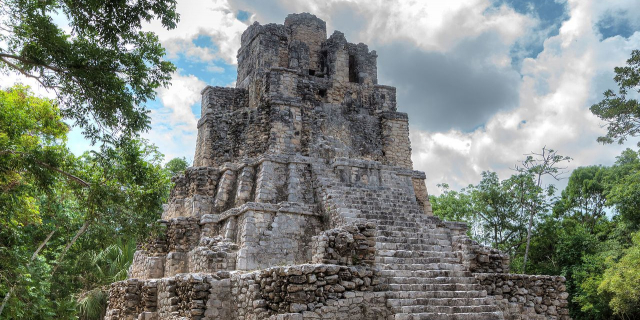Museo Subacuático de Arte
( Cancún Underwater Museum )The Cancún Underwater Museum (Spanish: Museo Subacuático de Arte, known as MUSA) is a non-profit organization based in Cancún, Mexico devoted to the art of conservation. The museum has a total of 500 sculptures, by a series of international and local sculptors, with three different galleries submerged between three and six meters (9.8 and 19.6 ft ) deep in the ocean at the Cancún National Marine Park. The museum was thought up by Marine Park Director Jaime González Cano, with the objective of saving the nearby coral reefs by providing an alternative destination for divers. It was started in 2009 and officially opened in November 2010.
At the beginning of 2008, Jaime González Cano began to create the plans for an underwater museum that would be formed by nature into a coral reef.[1]
Dr. Jaime González Cano, the Director of the National Park Costa Occidental Isla Mujeres, Punta Cancún y Punta Nizuc, saw that the natural coral reefs were being damaged by tourists, anchors, and divers. In particular the largest coral reef in Cancún, Manchones Reef, was receiving the most damage because it is the most often visited by divers and snorkelers.[2]
Early in 2005 González Cano suggested to the then President of the Cancún Nautical Association, Roberto Díaz Abraham, the idea of taking snorkelers and divers to an area where concrete reefs with some corals had been placed, to draw them away from Manchones reef. By January 2008, Díaz Abraham walked away from the project, believing that it would take many more years for the artificial coral gardens to flourish and become an attraction, but González Cano persisted and organized a meeting, where he presented the idea of deploying underwater concrete sculptures as artificial habitats to the advisory Nautical-Tourism Subcommittee. This, as a strategy to redirect visitors away from coral areas damaged by hurricanes and the accumulated impact of visitors. Having done research looking for an experienced underwater sculptor, Dr. González Cano came across Jason deCaires Taylor, who had been pioneering the use of underwater sculptures for the creation of artificial reefs on a project in Grenada that demonstrated the value of art in conservation, the Molinere Underwater Sculpture Park. He was a diving instructor in the Caribbean at the time, which also allowed him to see art in a different way.[3]
The Nautical-Tourism Advisory Subcommittee, where Roberto Díaz played an important role as President of the Nautical Association, agreed with the idea and to the plan presented by Dr. González for a series of artists to create an underwater sculpture museum. With Federal funds support, community participation and funds from the Nautical Association Trust, MUSA invited and hired Taylor to do the initial work of producing first 4 sculptures out of more than 500 that have been deployed. As he began to build up first sculptures, The National Park staff in conducted by Dr. González Cano, and with the collaboration of Roberto Díaz as President of the Nautical Association produced the Environmental Impact Assessment which, as from October 2009, provides the legal basis for the deployment of 1,412 artificial habitats, in 10 sites (galleries) of the National Park for the following 50 years. The park was enriched with other international artists such as a Mexican Artist Karen Salinas Martinez (Sculpted SEASCAPES), Mexican Artist Rodrigo Quiñones Reyes (sculpted BIOMAP), English Artist Jessica Miles and Nelson Gamboa from Colombia including an excellent team of local workers. The first four sculptures were deployed underwater in November 2009,[4] and most of Taylor's The Silent Evolution had been installed by the end of 2010.[5][6][7] The museum officially opened on November 27, 2010, shortly before the start of the Cancún climate summit.[8][9]
By the end of 2013, five years after the foundation of MUSA, a total of 500 concrete sculptures had been placed on the ocean floor. 477 are exhibited in the Manchones gallery and 23 in the Nizuc gallery. In addition, 26 replicas and one original are located at a visitor center at Plaza Kukulcán, a mall in the hotel zone of Cancún. More than 100,000 visitors, out of 500,000 that visited the Government Protected Area, visited MUSA during 2013.































Add new comment